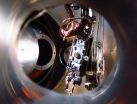(Press-News.org) Annual screening in women aged 40-59 does not reduce mortality from breast cancer beyond that of physical examination or usual care, concludes a 25-year study from Canada published on bmj.com today.
Furthermore, the study shows that 22% of screen detected breast cancers were over-diagnosed, representing one over-diagnosed breast cancer for every 424 women who received screening in the trial. Over-diagnosis refers to the detection of harmless cancers that will not cause symptoms or death during a patient's lifetime.
Regular mammography screening is done to reduce mortality from breast cancer. Women with small (non-palpable) breast cancer detected by screening have better long term survival than women with palpable breast cancer. But it is not clear whether this survival difference is a consequence of organised screening or of lead time bias (when testing increases perceived survival time without affecting the course of the disease) and over-diagnosis.
So researchers based in Toronto, Canada decided to compare breast cancer incidence and mortality up to 25 years in over 89,000 women aged 40-59 who did or did not undergo mammography screening.
Women in the mammography arm of the trial had a total of five mammography screens (one a year over a five year period), while those in the control arm were not screened.
Women aged 40-49 in the mammography arm – and all women aged 50-59 in both arms – also received annual physical breast examinations. Women aged 40-49 in the control arm received a single examination followed by usual care in the community.
During the 25 year study period, 3,250 women in the mammography arm and 3,133 in the control arm were diagnosed with breast cancer and 500 and 505, respectively, died of breast cancer. "Thus, the cumulative mortality from breast cancer was similar between women in the mammography arm and in the control arm," say the authors.
At the end of the five year screening period, an excess of 142 breast cancers occurred in the mammography arm compared with the control arm, and at 15 years the excess remained at 106 cancers. This, say the authors, implies that 22% of the screen detected invasive cancers in the mammography arm were over-diagnosed – that is, one over-diagnosed breast cancer for every 424 women who received mammography screening in the trial.
They stress that these results may not be generalisable to all countries, but say, in technically advanced countries, "our results support the views of some commentators that the rationale for screening by mammography should be urgently reassessed by policy makers."
While they believe that education, early diagnosis, and excellent clinical care should continue, they conclude that annual mammography "does not result in a reduction in breast cancer specific mortality for women aged 40-59 beyond that of physical examination alone or usual care in the community."
In an accompanying editorial, Dr Mette Kalager and colleagues believe that long term follow-up does not support screening women under 60.
They agree with the study authors that "the rationale for screening by mammography be urgently reassessed by policy makers," but point out that this is not an easy task "because governments, research funders, scientists, and medical practitioners may have vested interests in continuing activities that are well established."
INFORMATION:
Research: Twenty five year follow-up for breast cancer incidence and mortality of the Canadian National Breast Screening Study: randomised screening trial
Editorial: Too much mammography END
Annual screening does not cut breast cancer deaths, suggests Canadian study
Value of breast screening should be reassessed, say researchers
2014-02-12
ELSE PRESS RELEASES FROM THIS DATE:
New way to measure electron pair interactions
2014-02-12
WASHINGTON D.C. Feb. 11, 2014 -- Shoot a beam of light or particles at certain special materials and you will liberate electrons -- pairs of them -- a phenomenon known as "electron pair emission," which can reveal fundamental properties of the solid and reveal information necessary to design novel materials for future applications.
Measuring electron pair emission has always been difficult, however, because they were traditionally done using highly expensive synchrotron light sources, which are available in only a few laboratories worldwide. Nobody has found a way to ...
Could pizza herb prevent winter vomiting disease?
2014-02-12
Scientists have found that carvacrol – the substance in oregano oil that gives the pizza herb its distinctive warm, aromatic smell and flavour – is effective against norovirus, causing the breakdown of the virus' tough outer coat. The research is published today (12 February) in the Society for Applied Microbiology's Journal of Applied Microbiology.
Norovirus, also known as the winter vomiting disease, is the leading cause of vomiting and diarrhoea around the world. It is particularly problematic in nursing homes, hospitals, cruise ships, and schools, and is a very common ...
Satellite tracking identifies Atlantic Ocean risk zones for leatherback turtles
2014-02-12
Researchers used data from satellite transmitters attached to the turtles to track their movements across the Atlantic Ocean. These movements were then overlapped with information on high pressure fishing areas to identify where the turtles are most susceptible to becoming entangled and where they may drown.
The international study, jointly led by Dr Matthew Witt of the University of Exeter and Dr Sabrina Fossette of Swansea University, found that urgent international efforts are needed to protect the iconic species.
Between 1995 and 2010, a total of 106 leatherback ...
Three doses of HPV vaccine recommended against genital warts
2014-02-12
Two doses of vaccine against human papillomavirus (HPV) provide good protection against genital warts, but three doses is better according to an extensive register study by researchers at Karolinska Institutet in Sweden. The results are published in the scientific periodical JAMA.
Since 2012, girls in Sweden between the ages of 10 and 18 are offered free vaccination against HPV. The vaccine provides protection against various types of HPV, including some that cause cervical cancer and those that cause genital warts. Current recommendation is three doses of the vaccine ...
Exercise may slow retinal degeneration
2014-02-12
Moderate aerobic exercise helps to preserve the structure and function of nerve cells in the retina after damage, researchers at the Emory Eye Center and the Atlanta VA Medical Center have found.
The findings, from a study of an animal model of age-related macular degeneration, are the first to suggest that aerobic exercise can have a direct effect on retinal health and vision.
The results are scheduled for publication Feb. 12 in the Journal of Neuroscience.
Senior authors are Machelle Pardue, PhD and colleague Jeffrey H. Boatright, PhD at the Atlanta VA Center for ...
Smoking cessation may improve mental health
2014-02-12
Health professionals who treat people with psychiatric problems often overlook their patients' smoking habits, assuming it's best to tackle depression, anxiety or substance abuse problems first. However, new research at Washington University School of Medicine in St. Louis shows that people who struggle with mood problems or addiction can safely quit smoking and that kicking the habit is associated with improved mental health.
The study is published online in the journal Psychological Medicine.
"Clinicians tend to treat the depression, alcohol dependence or drug problem ...
Man's best friend equally adapted to high altitudes of Tibet
2014-02-12
As humans have expanded into new environments and civilizations, man's best friend, dogs, have been faithful companions at their sides. Now, with DNA sequencing technology readily available to examine the dog genome, scientists are gaining new insights into canine evolution.
In a new study published in the journal Molecular Biology and Evolution, author Dong-Dong Wu, et. al., explored the genetic basis of high-altitude adaptation of Tibetan Mastiffs, which were originally domesticated from the Chinese native dogs of the plains. The authors examined genome-wide mutations ...
NASA still sees some high thunderstorms in Tropical Cyclone Fobane
2014-02-12
VIDEO:
This TRMM flyover is a simulated 3-D view of Fobane that shows a few powerful thunderstorms near the center were reaching heights of over 14km (~8.7 miles) on Feb. 11....
Click here for more information.
Tropical Cyclone Fobane was located southeast of Reunion Island in the southwest Indian Ocean when the TRMM satellite passed over and captured rainfall and cloud data on the storm. TRMM saw that despite Fobane weakening, there was still some punch left in a few of the thunderstorms ...
Tech products can turn uncool when they become too popular
2014-02-12
In the tech world, coolness takes more than just good looks. Technology users must consider a product attractive, original and edgy before they label those products as cool, according to researchers.
That coolness can turn tepid if the product appears to be losing its edginess, they also found.
"Everyone says they know what 'cool' is, but we wanted to get at the core of what 'cool' actually is, because there's a different connotation to what cool actually means in the tech world," said S. Shyam Sundar, Distinguished Professor of Communications, Penn State, and co-director ...
NIH-funded researchers use antibody treatment to protect humanized mice from HIV
2014-02-12
NIH-funded scientists have shown that boosting the production of certain broadly neutralizing antibodies can protect humanized mice from both intravenous and vaginal infection with HIV. Humanized mice have immune systems genetically modified to resemble those of humans, making it possible for them to become HIV-infected.
Led by David Baltimore, Ph.D., of the California Institute of Technology, the investigators inserted the genes encoding the NIH-discovered broadly HIV neutralizing antibody VRC01 into a vector, a virus that infects mice but does not cause disease. In ...
LAST 30 PRESS RELEASES:
New study highlights link between eviction rates and gun violence
Heatwaves heat up soil but not toxin levels in rice, study finds
Digital modeling reveals where construction carbon emissions really come from
Turning farm waste into water filters
New study shows how the spleen helps the immune system accept a transplant
New Mayo Clinic study advances personalized prostate cancer education with an EHR-integrated AI agent
Researchers identify novel therapeutic target to improve recovery after nerve injury
Microbes in breast milk help populate infant gut microbiomes
Reprogramming immunity to rewrite the story of Type 1 diabetes
New tool narrows the search for ideal material structures
Artificial saliva containing sugarcane protein helps protect the teeth of patients with head and neck cancer
Understanding the role of linear ubiquitination in T-tubule biogenesis
Researchers identify urban atmosphere as primary reservoir of microplastics
World’s oldest arrow poison – 60,000-year-old traces reveal early advanced hunting techniques
Bristol scientists discover early sponges were soft
New study uncovers how rice viruses manipulate plant defenses to protect insect vectors
NSF–DOE Vera C. Rubin Observatory spots record-breaking asteroid in pre-survey observations
Ribosomal engineering creates “super-probiotic” bacteria
This self-powered eye tracker harnesses energy from blinking and is as comfortable as everyday glasses
Adverse prenatal exposures linked to higher rates of mental health issues, brain changes in adolescents
Restoring mitochondria shows promise for treating chronic nerve pain
Nature study identifies a molecular switch that controls transitions between single-celled and multicellular forms
USU chemists' CRISPR discovery could lead to single diagnostic test for COVID, flu, RSV
Early hominins from Morocco reveal an African lineage near the root of Homo sapiens
Small chimps, big risks: What chimps show us about our own behavior
We finally know how the most common types of planets are created
Thirty-year risk of cardiovascular disease among healthy women according to clinical thresholds of lipoprotein(a)
Yoga for opioid withdrawal and autonomic regulation
Gene therapy ‘switch’ may offer non-addictive pain relief
Study shows your genes determine how fast your DNA mutates with age
[Press-News.org] Annual screening does not cut breast cancer deaths, suggests Canadian studyValue of breast screening should be reassessed, say researchers


